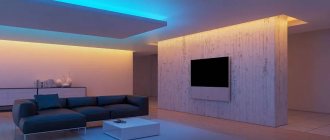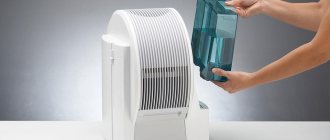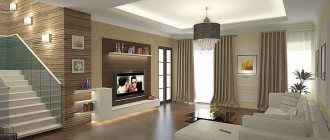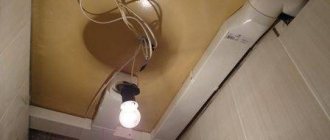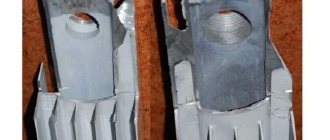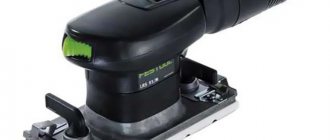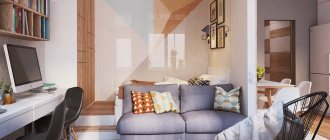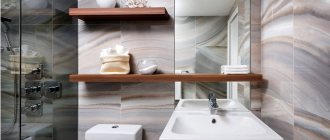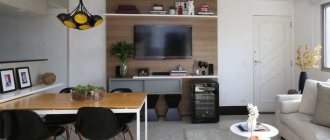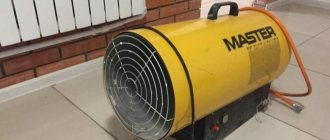Why they?
It would seem that the choice of materials is quite wide - in addition to those already mentioned, wallpaper, aluminum, paint, laminate, wood and much more are used for finishing ceilings.
However, there are some nuances here: only suspended ceilings and tension fabric do not require preliminary leveling of the floors and do not require additional treatment against moisture, corrosion and parasites.
On the contrary, they help hide all the imperfections of the rough finish, provide an even coating and, due to their composition, are not attractive to insects and rodents.
It would seem that everything is elementary - you can choose the material that you like best in appearance. However, is this really so? We invite you to compare all the characteristics step by step. What if significant differences tilt your choice in one direction or another?
Whitewash, paint and plaster
To paint, whitewash or plaster the surface, you will have to tinker, but the height of the walls will remain the same. These finishing options are suitable for most styles - classic, modern, historical, rustic, ethnic.
Lime and chalk
Despite the fact that the range of finishing materials is becoming larger and larger, the good old whitewash has not gone away. Its composition is very simple - it is an aqueous solution of slaked lime or an aqueous solution of chalk. The characteristics of these solutions differ. Lime has the following properties:
| Pros of lime | Cons of lime |
| Hides minor surface defects well | The color is white, but not bright |
| Has bactericidal properties | It smells unpleasant during the whitewashing process, but after drying there is no smell |
| Resistant to moisture | May cause allergies |
Chalk has its advantages and disadvantages:
| Pros of chalk | Disadvantages of chalk |
| Paints ceilings and walls bright white | It does not have the same masking qualities as lime, so the surface will have to be more carefully prepared for whitewashing |
| Has a neutral odor | Not bactericidal |
| Hypoallergenic | Not suitable for wet environments |
IMPORTANT . If the ceiling has already been covered with lime, then in the future you need to use such a solution. And if the surface is covered with chalk, then the new layer should be chalk. But chalk and lime are incompatible.
Dye
Water-based matte paint is best suited for painting the top - it is odorless and dries quickly. As for preparing the surface for painting, people here are divided into two camps - supporters of perfectly smooth ceilings and those who calmly paint directly over concrete or rough putty. But there shouldn’t be any controversy here - it’s just that some trends in interior design really allow for slight negligence.
Plaster - textured and structural
Textured plaster allows you to create the desired relief on a layer that has not yet dried. Only those specialists who have at least some artistic abilities should be involved in such work.
And the pattern of structural plaster manifests itself during the process of applying the solution. This happens thanks to the special components in its composition.
Careful leveling of the plane is not required - plaster will hide the imperfections. This coating is environmentally friendly and durable.
This decorative plaster on the walls and ceiling creates the illusion that the house is built of sand
general information
Before moving on to a detailed analysis, I would like to briefly explain what both types of coverage are.
Suspended plasterboard ceilings are mounted on metal profiles. It should be noted that the process is quite simple, especially if you are familiar with the technology of its installation, but it consists of a number of additional works.
The tension fabric does not need a frame - to install it you will need a profile around the perimeter of the room and a heat gun to warm the room (if we are talking about PVC film).
Lamps for slatted ceilings
The most suitable lighting solutions for slatted ceilings are spot devices and raster lamps. For the first case, lamps of any type are suitable, and for the second - fluorescent or LED.
Incandescent lamp
Since incandescent lamps have large overall dimensions compared to other lighting points, it is necessary to calculate the optimal ceiling level in advance. Such lamps have a low cost, but consume a lot of energy during operation.
The advantage is soft light, close to natural light, and good color rendition. One of the disadvantages is the inability to install dim lighting for the recreation area.
What about the price?
We think you will not argue with the fact that repairs are far from the cheapest pleasure. And of course, the issue of price for materials plays an important role in this.
Let's see what is cheaper to use - a suspended or suspended ceiling?
1. Cost of materials
Previously, we have already described in detail how the price of suspended ceilings is formed. PVC film starts on average from 160 rubles per square meter and sometimes can reach 1500. It all depends on the manufacturer, texture, type of material. You can find a cheaper option. But are you sure that it is rational to use Chinese noname in residential premises? Think about your safety.
As for the fabric tension covering, it will cost more: from 500 to 3000 rubles.
Of course, we are talking about a simple plain fabric. If we talk about printed ones, the amount will be even higher.
A plasterboard suspended ceiling is more democratic in this regard. On average, one sheet (2.5 x 1.2 meters) is sold for 80 rubles.
But there are also some nuances here. Much depends on the density of the material and its type. For example, if you want to buy waterproof gypsum boards, be prepared to spend money - from 300 rubles per sheet.
2. Cost of work
As you understand, your expenses do not end with the purchase of canvas or plasterboard. Still to be installed. It’s good if you feel strong enough to install the coating yourself (if anything, our step-by-step instructions collected in this section can help with this).
If not, then here are the approximate prices you need to focus on.
Average prices for installing a stretch ceiling are 200 rubles per meter for PVC film and 350 for fabric. If the premises have a non-standard configuration, builders may request more - from 700 rubles.
By the way, we have already told you what the final price of a stretch ceiling per square meter is made up of.
However, it is unlikely that you will be able to save money on a plasterboard suspended ceiling: installation work costs about the same, from 250 rubles. However, it all depends on the configuration of the room and a number of points. Lighting layout, design complexity, area... These parameters can significantly affect the cost.
What conclusions can be drawn? The cost of gypsum board is an order of magnitude cheaper than stretched fabric (especially fabric). But what will be the final cost along with installation and finishing work? Read on.
Grilyato - openwork ceiling
Decorating the ceiling in the form of Grilyato bars is a favorite technique of designers of large premises: shopping and exhibition halls, train stations, and other public spaces. It solves many problems:
- ensures fire safety;
- facilitates access to communications during repairs;
- creates an interesting design;
- ensures strength and durability of the structure.
The Grilyato ceiling in the apartment looks impressive and unusual
Material
Grilyato modules are aluminum gratings made up of U-shaped profiles. The material is not subject to corrosion and can last up to 30 years. A variety of colors, shapes and sizes of cells create room for creativity. Grilyato can be combined with drywall to form multi-level compositions.
Table. Characteristics of Grilyato models
| Name | View | Description |
| Standard | Raster tiles are installed on a Y-shaped profile. Simple and cheapest installation option. | |
| Blinds | A grid with compacted cells “tightly” masks communications and closes the space under the ceiling. | |
| Pyramid | The cells have the appearance of a truncated pyramid, which visually increases the height of the room. They look interesting when decorating multi-level surfaces, slopes, and gently sloping attic vaults. | |
| Multi-level model | Cellular profiles of different heights, shapes and colors will help create an interior of any complexity |
By the way: Grilyato grilles provide a unique opportunity for installing ceiling lighting. The play of light and shadow, a variety of colors create amazing effects and a festive mood.
Grilyato lighting capabilities
Pros and cons
The main disadvantage of raster ceilings is the insufficient camouflage of communications: ventilation pipes, cables, wiring. They are visible through cellular structures. The advantages of ceilings clearly outweigh their disadvantages.
- Easy installation without dust or unnecessary noise.
- Ventilation of the ceiling space.
- Cost-effective material and installation, durability - ceilings retain their performance characteristics for up to 30 years.
- Easy replacement of damaged fragments.
- Variety of colors and finishes
Video. All the nuances of installing Grilyato
Features of installation of suspended and suspended ceilings
An important point in choosing a coating is the complexity associated with installation. If you decide to carry out the installation yourself, we recommend that you read the instructions and think about whether you can really do it.
If you decide to turn to professional builders, there are nuances that need to be taken into account.
Let's study the table, which clearly shows all the features and differences in the installation of these two types of ceiling structures:
| Characteristic | Stretch ceiling | Suspended ceiling |
| Possibility of self-installation | The smaller the area, the greater the chances of success. Two or three assistants are needed in any case. Plus you will need a heat gun (it is not needed for fabric sheets). Otherwise, the process is quite simple and after studying all the details and watching a couple of videos, you will master it. | It all depends on the configuration of the ceiling. If it is a one-level structure without decorative elements, you can handle it yourself. However, if you have chosen a more complex option with level transitions, voluminous shaped inserts or slots, it is better to order professional installation. |
| Cleanliness of the process | Let's be honest, it is quite difficult to litter when installing a stretch ceiling. True, there is a risk of damaging the wall covering with a heat gun or spatula, but if you work carefully, this will not happen. | There will be dust and construction debris here. Therefore, you will have to cover the walls if you are concerned about their finish. In addition, it is recommended to remove all furniture from the room. |
| Loss of altitude | To install the tension fabric, keep in mind that a single-level structure will take at least 5 centimeters. If it is necessary to hide the pipes, then this parameter may increase. With a multi-level ceiling, everything depends on the design decision. | If the walls in the room are lower than 2.5 meters (builders call 3 the optimal height), then it is better to abandon the idea of suspended ceilings. They hide 10 centimeters of space - you must agree, not the best choice for a small room. |
| Lighting installation | Hidden LED lighting, spotlights, various chandeliers... Your imagination is practically unlimited. Any type of lighting can be easily installed on the stretched fabric. The ability to unfasten the canvas, repair the wiring, and then attach it back depends on the stretch ceiling fastening system. | As with suspended ceilings, you can install almost any lighting fixture. It is recommended to make a hidden hatch to get to wires or communications if necessary. |
| Installation speed | The average installation time for canvas in one room is from 3 to 6 hours. And this takes into account the fastening of baguettes and masking tape, measurements, installation of wiring for lighting. | It will take more time: from 2 to 10 days. The period greatly depends on the complexity of the design and who carries out the installation. |
As you can see, the features of installation technologies can hardly help you decide - each option has its own advantages, and there is no need to talk about specific disadvantages.
Let's see how else a suspended ceiling differs from a suspended ceiling?
From the floor to the top
Conventional flooring can also end up on other planes. Among such universals, the first places are occupied by laminate and cork.
Laminate
There is no special ceiling laminate - the same one used for the floor is used. At the same time, you can safely choose not the most durable types, because the load on it will be small.
Preference is given to the lightest colors - white, grayish, yellowish and beige. The wood-imitating coating has shades such as white oak, light walnut and ash. In tall and well-lit rooms, you can safely use dark colors.
ADVICE. There is no need to use the same shade of laminate both below and above - such an interior will turn out to be too monotonous and flat.
Laminate can also imitate metal, stone, concrete and other materials. And, if “wood” is suitable for a modern style, then “metal” will look great in a high-tech interior, “stone” in a Gothic setting, and “concrete” in a loft.
Laminate flooring on a high ceiling can easily be confused with natural wood
Cork tree
Another option for finishing the ceiling is to use balsa wood. This material has the following advantages:
- environmental friendliness;
- variety of shades;
- thermal insulation;
- soundproofing;
- small thickness;
- the ability to bend panels in order to trim various protrusions with them;
- resistance to fungus;
- water resistance.
One of the disadvantages is that the cork must be coated with wax or varnish. This material is difficult to work with and there is a risk of damaging it during installation. Therefore, it is impossible to do without professionals.
This cork ceiling is especially good for living rooms
Maintaining order
It’s not enough to finish the finishing touches. It is necessary to maintain the coating in decent shape, otherwise the entire impression of the new renovation will quickly deteriorate.
Therefore, how the ceiling behaves in operation is an important nuance that you should pay attention to when making a choice.
Stretch ceilings made of PVC film are perhaps the most convenient material in this aspect.
They just need to be wiped with a soft damp cloth. In case of heavy soiling, you can add a non-abrasive detergent, such as dishwashing detergent or regular liquid soap. There are no streaks left on them, they are easily washed off from dirt... Perhaps, in this regard, they are ideal.
With a fabric stretch ceiling it will be more difficult - especially when it comes to trying to wash off the stain. The fact is that if you rub (even gently) the same place on the fabric for a long time, lint will form there. That is, you will wash off the stain, but at a certain lighting angle it can be noticeable (and this is forever) that something is wrong in that place as everywhere else. In terms of wiping dust, there won’t be any special problems here: wipe with an almost dry soft cloth with minimal pressure on the ceiling.
Suspended plasterboard structures require much more attention. You are unlikely to wash them, but you will definitely have to paint them once every 5-7 years. This is especially true for colored ceilings. A soft, colorless cloth wrung out as much water as possible will help get rid of dust.
Wallpaper
Let's look at some types of wallpaper suitable for ceilings.
Paper, vinyl, non-woven and textile
Paper wallpaper is the most budget-friendly. And if the choice falls on them, then it is better to prefer two-layer ones - the image on them can be either flat or convex. Paper is the most environmentally friendly and breathable finishing material, but that’s where its advantages end.
Non-woven wallpaper is divided into two subtypes - completely non-woven and combined. The latter have only a non-woven base, and the outer side can be vinyl or some other.
BY THE WAY. Wallpaper consisting entirely of non-woven fabric can be painted, and more than once.
Vinyl wallpapers are denser, but they are rarely painted. In addition, this type of canvas is not recommended for use in the kitchen - it absorbs odors.
Textile wallpaper looks cozy and presentable, but you should not try to glue it yourself without experience.
ADVICE. If you have to choose between wallpaper and paint, experts advise taking into account the age of the house. New buildings shrink during the first few years and microcracks appear on the surfaces. And good wallpaper can hide them. And it is better to use paint in houses that are more than 5 years old.
If the ceiling is high enough, choose a large wallpaper pattern - then you can examine it in detail
Liquid wallpaper
This material is a dry mixture of textile fibers and cellulose. Before applying to the surface, the mixture is diluted with water. The advantages of liquid wallpaper are the absence of seams and maintainability. If any area is damaged, it can be “patched” with the remaining mixture.
BY THE WAY . The design of fillets—plinths made of foam plastic or other materials—helps to achieve a neat boundary between the ceiling and the wall.
Liquid wallpaper can be tinted yourself if the desired shade is not available for sale.
Which is stronger?
Of course, we doubt that you will deliberately spoil the fresh coating (and if so, we suggest you read the tips on how to do this in a fun way using the example of suspended ceilings). Therefore, we recommend that you think about how the materials will behave in everyday life - after all, different situations happen.
PVC sheets are not particularly durable - they are quite easily damaged by being caught with a sharp object or simply hit with sufficient force. That is why in the nursery it is recommended to place them taking into account the child’s behavior: if he is a fan of active games, it is better to choose another option. Fabric ceilings in this regard are more resistant to mechanical stress (except for piercing and cutting tests).
Suspended structures are much stronger. However, if you set a goal, you can break them by throwing something heavy. True, the repair will be much simpler - if you tear the tension fabric, you will have to change the entire covering. Immediately, it will be enough to carefully cut out the damaged area and replace it with a whole piece of drywall, carefully masking the joints.
As you can see, in this regard, plasterboard suspended ceilings outperform their stretch competitor.
Facing materials
The cladding will hide unevenness well, and will take away quite a bit from the height of the room. Materials for the top differ in their properties from those intended for walls. Firstly, they should be as light as possible. Secondly, strength is not so important for them.
Ceiling tiles
The advantages of this three-dimensional tile imitating molding are its low weight and low price. This material may look beautiful, but is often used to save money and time. The tiles are installed quickly - just glue them to the surface with special glue. At the same time, it must be applied carefully - only to the middle of the tile - without allowing it to leak out along the edges.
Expanded polystyrene tiles come in three types: pressed, laminated and seamless. Laminated is a suitable option for the bathroom and other wet areas. Seamless is good for the living room and other living rooms. Pressed tiles are the most fragile.
IMPORTANT. In kitchens with a gas oven, any polystyrene foam tiles will quickly lose their appearance.
The most common type of ceiling tile
Brick
Real brick is used only for the construction of vaults. But the facing is also suitable for decorative finishing of the top. Alternative options are also used - from drywall, plaster or carved foam.
Brick can be painted any color
In case of fire
If you believe the manufacturers' assurances, both materials are non-flammable and therefore absolutely safe for use.
Essentially this is true. However, as elsewhere, there are some things marketers prefer to keep silent about.
The tension fabric, no matter whether it is fabric or PVC film, has a chemical composition. Therefore, when heated, which inevitably occurs during a fire, it begins to release toxic substances into the air. Agree, this is not very pleasant.
Technologists classify plasterboard as a material with a moderate degree of toxicity and low flammability. That is, smoke harmful to health is released into the air in an amount of no more than 50 m²/kg. This is five times less than a regular log fire. That is, the suspended ceiling is considered quite safe.
However, there is a nuance: when heated for a long time, it loses its load-bearing properties and simply collapses. Resistance varies depending on the density, thickness of the sheet and... frame. If it's made of wood, even the best quality drywall won't last long.
In Vasmer Max's dictionary
ceiling kind p. -lka, dial. genus. n. ceiling, cf. also blr. ceiling. Probably from *ceiling from *tlo “bottom”. Wed. lit. pãtalas “bed”, Old Prussian. talus “floor”, Old Indian talam wed. R. “flat, plain”, tаlas – the same, d.-v.-n. dilla “board, floorboard”, lat. tellūs w. “earth, soil”, Irish. tаlam – the same (Trautman, BSW 321; Zubaty, AfslPh 16, 417; Pedersen, Kelt. Gr. 1, 132; Specht 23). Wed. lintel, ground. •• (Pisani (Ricerche linguistiche, 1, 1950, p. 271 et seq.) tries to explain this word by the influence of the word ceiling - from *polatok from *polat = Latin palātum, originally “vault”, and gives examples of combining meanings. “(sky) vault”, and “ceiling” in Greek, Lat., English; explanation, following Miklosic and Dahl, ceiling: potlknѫti, Russian pound “to trample”; see Lepis e, collection "Problems of history and dialectology of Slavic languages", M., 1971, pp. 170 et seq. - T.)
If flooded
The saying that you can always stare at fire and water is absolutely not true in the case of domestic disasters. We doubt that anyone is able to meditate while watching their neighbors flood them.
If water flows onto the suspended ceiling, but it was installed correctly and airtight, then the canvas can withstand up to 100 liters of water per square meter.
This way, the flood will not have global consequences: furniture and equipment will not be damaged, and call specialists to drain the water. This property is especially useful for old houses, for example in Khrushchev, where pipes are often in less than ideal condition.
Areas of use
Typically, tension and suspension systems are used in brick and panel houses, where the ceiling can protrude with varying levels of differences from 3 to 7 cm. Not everyone can level such a surface; professional skill is required, so ceiling systems are an easy way to solve the problem without cost time and resources.
Constructions come to the rescue if it is impossible to remove water-based paint or old wallpaper that was used to cover the work surface. If you leave the old coating, the new paint or tile will not adhere well. When you need to make spot lighting in a room, systems of this type are the best option. The lamps can be placed as desired, and the electrical wiring parts are well hidden inside the structure.
Is it necessary to change the canvas in this case?
No if:
- a little water flowed in and the ceiling did not sag more than 3 cm;
- and we are talking about PVC fabric.
Yes, if:
- fabric (in any case), so it becomes saturated with water and leaves an indelible mark;
- The PVC fabric has stretched by more than 3 cm;
- fallen plaster or other particles from the rough ceiling damaged the canvas;
- if to drain the water you need to disconnect the edge of the canvas, but it was attached to a clip system.
With a suspended ceiling, everything is simple: first the gypsum board will become damp, absorbing water, and after a few moments the water will flow further into the room.
How to disassemble a ceiling
The structure is dismantled in the reverse order. First, the lamps are removed, then the baseboards are unfastened and after that they begin to dismantle the suspension system. The slatted ceiling is dismantled from the outermost plank, the panel is pryed up with a screwdriver and carefully pulled towards you.
Thus, the rail is pulled out from the profile in which it was built. After removing all the panels, they begin to dismantle the guides; to do this, loosen the spring clamps and disconnect the tires from the suspensions.
Subscribe
Which ceiling will last longer?
If you want to get attractive information that ceilings can be almost eternal, you better read the manufacturers’ advertising website. This applies to both types of coverage.
In reality, everything is not as rosy as they try to convince us.
According to official assurances, stretch ceilings last up to 20 years. However, it is not. Even the highest quality coating begins to lose its properties after an average of 5-7 years. Elasticity, moisture resistance, smooth fabric without wrinkles... As soon as a certain period passes, you can forget about it.
The period may be longer, it all depends on the operating conditions. But we still don’t recommend counting on a couple of decades without repairs.
With drywall, everything is not so simple. On the one hand, a suspended ceiling can actually withstand up to 10 years of service. On the other hand, there is a possibility that you will have to renew the coating much earlier - minor scuffs, faded paint, cracks at the joints... But all this is not a full-scale repair, which threatens you in the first case.
Amstrong - cheap and practical
Models of the English brand Amstrong have gained popularity and are considered a separate type of suspended ceilings, although they belong to the classic cassette type. The modules are made of mineral raw materials - stone wool embedded with latex or starch. Environmentally friendly raw materials make it possible to use cassettes for decorating dining rooms and children's rooms. Armstrong tiles reflect light and visually enlarge the space; a bonus is the soundproofing properties of the tiles.
Calculation diagram for installing Amstrong slabs
Amstrong models
Standard tiles of the brand have dimensions of 60x60 cm and thickness from 10 to 25 mm.
- Models Oasis and Bajkal are a budget option for ceiling coverings. The cost of 1 m2 of ceiling with a suspended system is 280-340 rubles. White and gray slabs with applied texture.
Oasis - texture in the form of a sandy surface
Baikal - wormholes imprinted on a white background - Bioguard - hygienic plates with an antibacterial layer that prevents the adhesion of fat; designed for kitchens and dining rooms, not afraid of fumes; used in medical institutions.
Biogard - slabs that are afraid of microbes
- Prima - moisture-resistant cassettes, retain their shape and quality at humidity levels above 90%, and have soundproofing and reflective properties.
Prima - premium cassettes
- Ultima is a designer class tile with increased sound insulation. The surface texture is finely drawn, the cassette is resistant to scratches and damage.
Ceiling Armstrong Ultima in the interior
Pros and cons of Amstrong ceilings
Amstrong ceilings are in demand due to the good price/quality ratio in budget models. A large assortment of accessories has been produced for the Armstrong models: lamps, ventilation grilles, baseboards, finishing items - all this allows you to create a harmonious and sophisticated interior.
Brand models have several disadvantages.
- Budget brands lose color when exposed to light and temperature changes; they cannot be used in baths, kitchens, or near heating appliances.
- Amstrong tiles are fragile and crack when impacted.
- The cassettes do not withstand long-term contact with water; they will have to be replaced in case of floods.
Decorated Amstrong looks very impressive
Resistance to temperature changes
Agree, maintaining the same temperature in the room is simply unrealistic. Therefore, we advise you to take into account the features of each coating.
Suspended ceilings can easily withstand almost any change. They are resistant to both frost and heat. Therefore, they are often chosen not only for finishing the interior of an apartment or house, but also for a terrace, balcony...
But it’s better not to install the tension fabric there: it loses its elasticity already at zero temperature, and if the thermometer drops to -5, the ceiling will have to be changed.
With heating, everything is not so simple: deformation begins at +60 degrees. Do you seriously think that if the room gets so hot, you will care about the appearance of the ceiling? This is where the information about flammability, located just above, will come in handy...
However, this is only relevant for PVC film - fabric ceilings can easily withstand any temperature regime.
Cassette ceilings - durability and ease of maintenance
Cassette structures are created from modules - individual tiles that are laid on a mounted frame. Standard sizes of square tiles: 30, 60 or 120 cm. The functional qualities of the coating depend on the material of the modules.
Cassette covering in the bathroom
Types of cassettes
The material used to make modules gives them a variety of properties:
- metal tiles (aluminum, galvanized, steel) – anodized or painted; durable, non-corrosive, resistant to moisture and temperature changes, easy to clean; used in rooms with high humidity;
- mineral fiber cassettes - slightly thicker than metal ones, have soundproofing qualities, and are environmentally friendly;
- mirror modules - expand the room and give it a luxurious appearance;
- tiles made of silicate or acrylic glass - create the effect of a translucent ceiling with soft lighting.
- perforated cassettes – have holes with a diameter of up to 2 mm; improve the acoustics and ventilation of the room.
Study: perforated ceiling
Installation
Installation of the cassette system is as simple as possible and does not require additional effort or extensive experience in repair work. In open-type ceilings, the frame profiles are not hidden by tiles and perform a decorative function. In closed structures, the load-bearing parts are hidden by cassettes. It is recommended to start work from the middle of the ceiling, cutting the modules along the walls.
Installation of cassette ceiling
Advantages and disadvantages
Cassette designs are popular when decorating ceilings with a large area: in hospitals, shopping centers, educational institutions, and institutions.
They have a number of undeniable advantages:
- easy installation;
- accessibility for organizing any lighting and ventilation systems; to repair internal communications, it is enough to remove a few tiles to carry out the necessary work;
- durability - tiles do not lose their appearance after many years of use; warranty period – 15 years;
- hygiene - just wipe the ceilings with a damp cloth;
- moisture and fire resistance – metal cassettes do not burn and are not covered with fungus from moisture.
Meeting room interior with cassette ceiling
Cons:
- frame structures conceal the height of the room and are therefore unacceptable for low rooms;
- metal modules are expensive: a real aluminum cassette (60x60) costs 400-450 rubles, budget options are not of high quality.
Living room: spectacular diamond trim at the junction of cassettes
Which ceilings have more design options?
Another important aspect is the variety of design elements. Of course, you want the apartment to be pleasing to the eye. You can see more successful examples of design in our thematic photo collections - we are sure there will be a lot of interesting things there.
Stretch ceilings have a huge number of variations. Different textures (glossy, matte, satin, velvet, translucent...), a wide range of colors, photo printing, hidden LED lighting, vinyl stickers... And the range of decorations is not limited to this - they are truly almost unlimited.
Almost the same thing is said about suspended ceilings. Except, perhaps, for the variety of textures. However, multi-level hanging structures with carved decorative slabs look simply stunning. In addition, to give them originality, they use wallpaper, a variety of paints, and all kinds of inserts.
General advantages of suspended ceilings
- Aesthetic.
- They mask base defects without the need for rough work.
- Suspended ceilings are located at a distance of 10 - 25 cm from the main ceiling. Wires, pipes, air ducts, etc. are placed in the resulting useful space. It is also possible to attach directly to the base base.
- They allow you to arrange effective lighting by using not only the central chandelier, but also additional light sources.
How to choose the best coverage?
Criteria for choosing a finishing option:
- Microclimatic indicators of the room, purpose. For example, in the bathroom there is high humidity, so it is better to take moisture-resistant material. In addition to humidity, the kitchen is characterized by severe pollution and temperature changes. A material that can withstand frequent cleaning is suitable here. Important: When decorating a bedroom, pay attention to the environmental friendliness, vapor-proof, and sound-proofing properties of the material.
- Dimensions, room height. A room with a low ceiling will lose an additional 10 cm if you install a suspended ceiling, but it will correct the shape of a space that is too narrow or wide. Matte ones softly diffuse the rays of light, while glossy ones will visually enlarge the room and reflect light.
- Interior style. The classic style is emphasized by a smooth, light surface; a modern multi-level design is appropriate for trendy interiors.
- Difficulty level. Not all types of finishing are done independently. Some of them can only be done by highly qualified craftsmen.
- Financial opportunities. The price of materials depends on their type: from wooden panels made to order to the simplest ones available to everyone.
Lifetime
One of the most important factors when choosing is durability. Manufacturers of PVC sheets determine the service life of products - more than 20 years (with proper care).
However, not everything is so simple here. Much depends on the cost and quality of the material. Durable and expensive PVC film can last the specified period. Materials in the mid-price category may lose their attractive appearance after 7-9 years of service. Such coating will have to be replaced 12-15 years after installation.
Suspended systems can last 20-30 years, but there is another nuance. They should be repainted every 6-8 years. It’s hard to say which is preferable – simple maintenance over a long period of time or regular updates with a long service life. The choice depends only on the personal preferences of the owner.
